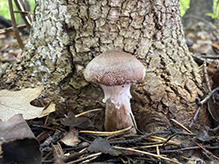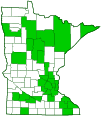Bulbous Honey Fungus
(Armillaria gallica)
Conservation • Description • Habitat • Ecology • Use • Distribution • Taxonomy
Conservation Status |
|
|||||||
| IUCN Red List | not listed |
|||||||
| NatureServe | NNR - Unranked |
|||||||
| Minnesota | not listed |
|||||||
Description |
||
Bulbous Honey Fungus is a common, late season, gilled mushroom. It occurs in Europe, Asia, and North America. In the United States it occurs east of the Great Plains and in the west from Washington to central California west of the Rocky Mountains. It also occurs across southern Canada and in central Mexico. It appears in late summer and fall, alone, in groups (gregarious), or is loose small clusters. It is found most often growing on the ground attached to underground roots, but it is also found on stumps and logs and on the base of living trees. It grows usually on hardwoods but also occasionally of conifers. It usually obtains its nutrients from dead wood (saprobic) but can also attack living trees weakened by disease (parasitic). When it first appears the cap is convex and pinkish-brown or brownish-yellow. The upper surface may be dry or sticky. It is hairless but is covered with slender, erect or upward sloped fibers (fibrils). The gills are covered with a white, cottony, layer of tissue (partial veil) extending from the margins of the cap to the stalk. As it ages the cap expands, becoming broadly convex to almost flat. Shreds of tissue, remnants of the partial veil, hang from the margin. As it dries out it fades considerably toward the edges while remaining dark in the center. Mature caps are 1″ to 3¾″ (2.5 to 9.5 cm) in diameter. The margins are lined. The gills are whitish, closely spaced, and broadly attached to the stalk (adnate), sometimes slightly running down the stalk (decurrent). As they age they turn pale orange and develop rust-colored spots. They turn pinkish to brownish when bruised. Between the main gills there are two or three series of short gills that do not extend to the stalk. The stalk is 1½″ to 4″ (4 to 10 cm) long and ¼″to 11⁄16″ (6 to 18 mm) thick. It is swollen at the base, appearing club-shaped. There is a flimsy ring of tissue, the remains of the partial veil, on the upper part of the stalk. Sometimes there is no ring just a yellowish ring zone. The stalk is whitish or pale pink, becoming grayish-brown on the lower half with age. The flesh is whitish. It does not change color when sliced. It is edible when cooked and has a mild to bitter taste. The spore print is white. The underground vegetative portion (mycelium) of this mushroom is often very extensive, sometimes covering several acres. Curiously, the mycelium is bioluminescent but the fruiting body (mushroom) is not. The purpose of the bioluminescence may be to attract insects that will disperse the spores, or to deter insects and animals that may eat it. It could also be a byproduct of other biochemical functions and have no other purpose. |
||
Similar Species |
||
Habitat and Hosts |
||
Hardwood and sometimes conifers |
||
Ecology |
||
Season |
||
Late summer and fall. |
||
Distribution |
||||
|
Sources |
|||
| 12/14/2022 | ||||
Occurrence |
||||
Common |
||||
Taxonomy |
|||
| Kingdom | Fungi (Fungi) | ||
| Subkingdom | Dikarya | ||
| Phylum | Basidiomycota (Basidiomycete Fungi) | ||
| Subphylum | Agaricomycotina (Higher Basidiomycetes) | ||
| Class | Agaricomycetes (Mushrooms, Bracket Fungi, Puffballs, and Allies) | ||
| Subclass | Agaricomycetidae | ||
| Order | Agaricales (Common Gilled Mushrooms and Allies) | ||
| Suborder | Marasmiineae | ||
| Family | Physalacriaceae | ||
| Genus | Armillaria (honey mushrooms) | ||
Species Group Species |
|||
Synonyms |
|||
Armillaria bulbosa Armillaria inflata Armillaria lutea Armillariella bulbosa |
|||
Common Names |
|||
Bulbous Honey Fungus |
|||
Glossary
Mycelium
The vegetative part of a fungus; consisting of a mass of branching, thread-like hyphae, through which a fungus absorbs nutrients from its environment; and excluding the fruiting, reproductive structure.
Parasitic
Obtaining nutrients from another living organism.
Partial veil
A protective covering over the gills or pores of a developing mushroom. At maturity it disappears, collapses into a ring around the stalk, or wears away into a cobwebby covering and ring zone.
Saprobic
A term often used for saprotrophic fungi. Referring to fungi that obtain their nutrients from decayed organic matter.
Visitor Photos |
|||||
Share your photo of this fungus. |
|||||
| This button not working for you? Simply email us at info@MinnesotaSeasons.com. Attach one or more photos and, if you like, a caption. |
|||||
Honey Fae (Farah) |
|||||
 |
|||||
MinnesotaSeasons.com Photos |
|||||
|
|||||

Slideshows |
||

Visitor Videos |
|||
Share your video of this fungus. |
|||
| This button not working for you? Simply email us at info@MinnesotaSeasons.com. Attach a video, a YouTube link, or a cloud storage link. |
|||
Other Videos |
|||
| Armillaria gallica Find In Nature - mycology, fungi |
|||
About
Dec 17, 2020 Armillaria gallica (Bulbous Honey Fungus) is a Honey Mushroom that normally grow on the ground and has a bulbous stem. I have found Armillaria gallica growing under beech trees but also growing in a pasture where there are no trees around in a 100 m radius. It is considered edible but is said to cause stomach upsets to more sensible people. The largest one that I found had about 15 cm in diameter. Other scientific names are Armillaria bulbosa and Armillaria lutea. |
|||
| Wild Mushroom Forage: Honey Mushroom Armillaria Gallica (bulbous honey mushroom) The Liu View |
|||
About
Nov 7, 2022 This mushroom is one kind of honey mushrooms. It’s in the family of Armillaria. It’s called Armillaria Gallica(bulbous honey mushroom). It’s considered edible after thoroughly cooked. But some people eat it and cause stomach upset. I cooked a little and tasted it. It’s good! But I regard it as an inedible mushroom. Because there is a deadly poisonous mushroom called deadly gallerina /Galerina marginata (G. autumnalis) alike . If you misidentified it and eat it. It will be lethal even you just eat a small piece. So don’t forage and eat It! |
|||

Created: 12/14/2022
Last Updated:


